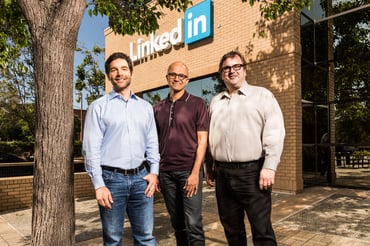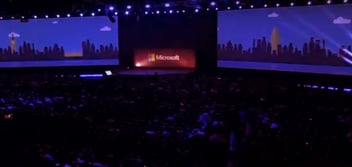Why Microsoft Bought LinkedIn for $26B
 As an IT recruitment specialist and Microsoft Partner that has developed recruitment software, it’s fascinating to hear the news of Microsoft’s purchase of LinkedIn.
As an IT recruitment specialist and Microsoft Partner that has developed recruitment software, it’s fascinating to hear the news of Microsoft’s purchase of LinkedIn.
While some are already questioning the $26 Billion acquisition cost, there are clearly some interesting synergies that can be played out with the two companies coming together.
Microsoft CEO, Satya Nadella, has been playing catch-up since he took the helm, following from Steve Ballmer’s misguided direction. While it proved too late for Satya to rescue Microsoft’s acquisition of Nokia and compete with Android and Apple’s dominance, I believe Satya is definitely on to something with LinkedIn.
Some have already suggested that this is a way for Microsoft to spam LinkedIn users into upgrading to Windows! This is very short sighted and here's why.
The introduction of Microsoft Office 365 - Microsoft’s cash cow that moved to the cloud – has been a fabulous success. While Google has undoubtedly made inroads with their productivity suite, there is no doubting the maturity and familiarity of the likes of Excel, Word, PowerPoint and Outlook.
Mobile first, social business
Building on the success of O365 and a vision of a mobile-first, socially connected world, Microsoft has leveraged the thriving platform with add-on apps. For example, Delve is a socially enabled tool available with O365 that helps business teams see information that is likely to be of interest to them now; surfacing relevant documents in OneDrive or SharePoint, for example. And Microsoft Dynamics CRM has increasingly sophisticated links with O365 that continue to break down the traditional user adoption barriers associated with customer relationship management.
Both Delve and Microsoft CRM could benefit from the data within LinkedIn – a source of information often more accurate than what’s found in a company’s customer database. Add Microsoft’s moves into machine learning and there are all kinds of repercussions, such as predicting a prospect’s propensity to buy based on their social behaviour or the type of language they use that points to a particular personality type. And consider Cortana – Microsoft’s voice-based assistant – reminding you about your 11am appointment with a customer it scheduled because your client’s activity on LinkedIn suggests there is now a 30% chance they will now shift allegiances. That kind of proactive insight is worth a lot of money.
Don’t forget that LinkedIn also owns Lynda.com, the online training provider. With the backdrop of a global digital skills shortage, Lynda.com gives Microsoft another inroad into affordably equipping people and businesses with the skills they’re going to need to keep up with the pace of the fourth industrial revolution we’re living through – a revolution Microsoft is in part fuelling.
Big challenges ahead
As well as the price Microsoft has had to pay to play, there’s one other fly in the ointment. Microsoft’s competitive position against Google has always come back to data privacy and trust: Google shares your data with its advertisers, Microsoft doesn’t. So it will be interesting to see how Microsoft continues to protect user privacy, while making use of the data to enrich its productivity suite. While LinkedIn is a different animal to Facebook, the work and play lines are blurring (have you seen some of the questionable posts on LinkedIn recently?), they are sure to face some as-yet unforeseen consequences with the power they will be able to wield over people’s professional lives.
This is certainly a bold move for Microsoft. Under Satya’s guidance there’s no doubting that they are fully embraced a socially connected business landscape. And with the acquisition of LinkedIn they are now playing out their vision in a very public way.
Crimson will be attending Microsoft’s Worldwide Partner Conference this July. We’ll keep you posted on what we find out and how Microsoft continues to reinvent itself.



